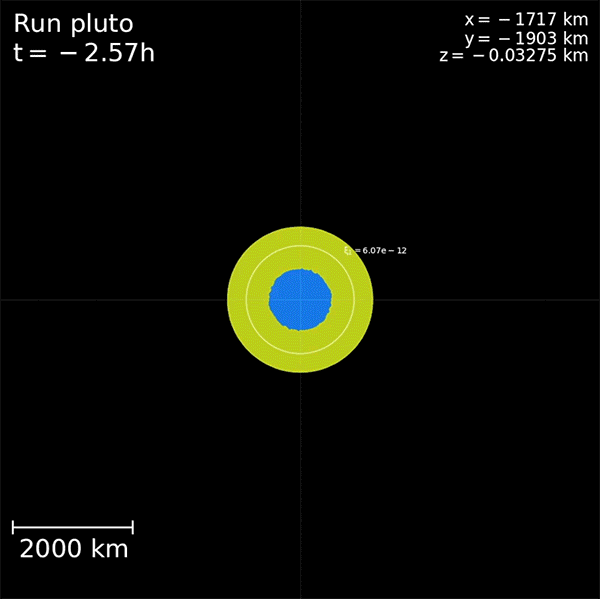Hello Nature readers, would you like to get this Briefing in your inbox free every day? Sign up here.

Simulations that include material strength suggest that Charon was captured relatively intact, which implies that Charon could be as ancient as Pluto. (C. Adeene Denton et al/Nature Geoscience)
Pluto might have hogged much of the spotlight historically, but the dwarf planet is actually part of a double act, alongside its biggest satellite, Charon. A new analysis suggests that Pluto used its gravity to entice Charon into this pas de deux, hugging the smaller body close before the two split into a whirling pair — a mechanism dubbed ‘kiss-and-capture’. Previously, scientists thought that the binary system formed as the result of a collision between two proto-bodies, with much of proto-Charon’s material sloshing over to proto-Pluto. The new idea suggests that Charon kept much of its core and mantle.
CNN | 7 min read
Reference: Nature Geoscience paper
OpenAI’s latest experimental chatbot model, o3, scored exceptionally well on a test that marks progress towards artificial general intelligence. Researchers are impressed with the results, but also caution that it’s hard to tell if the test really measures AI’s capacity to reason, plan and learn skills as well as humans can. “There have been a lot of benchmarks that purport to measure something fundamental for intelligence, and it turns out they didn’t,” says AI-benchmarking researcher David Rein. The hunt continues for ever-better tests, he says. But as AI systems improve, it is becoming harder and harder to develop tests that highlight a difference between human and AI capabilities.
Nature | 6 min read
External ears such as our own are made of a newly discovered form of lipid-filled cartilage that make them fabulously flexible. Researchers investigating vertebrates’ cartilaginous bits (which include the nose and larynx) looked at the ears of people and dozens of other mammal species and found that many share this ‘lipocartilage’, which wasn’t found in non-mammals. But our flappy flanges do have one big thing in common with the rest of the animal world, found a separate study: to build ears, mammals seem to reuse much of the cell types and gene programs that evolved to make gills in fish — and, even farther back in the evolutionary story, in invertebrates. “Our ears are potentially the evolutionary remnant of the first cartilage that existed,” says developmental biologist and study co-author J. Gage Crump.
Science | 6 min read
Reference: Science paper & Nature paper
Features & opinion
Research around the world has linked polluted air to increased risks of dementia, depression, anxiety and psychosis. Studies have also found links to neurodevelopmental conditions, such as autism, and cognitive deficits in children. Now a growing number of researchers are trying to determine how the gaseous and particulate components in the complex mix that we call ‘pollution’ do damage, and how much harm they cause.
Nature | 10 min read
Scientists must take an active role in stopping the frayed political relationship between the United States and China from driving their scientific communities further apart, argues a group of multidisciplinary researchers. Experts in both countries should champion ‘safe zones of research’ for collaborative work where the potential benefits outweigh political sensitivities. To make these collaborations successful, scientists must also secure funding for cross-border projects and be prepared to clearly communicate the benefits of their work to political sceptics. “Until the scientific community articulates a vision for how it wants collaborations to work, politicians will fill in the gaps,” the group writes.
Nature | 11 min read
There’s no set path to having a family while completing a PhD, with experiences varying hugely across regions. “Oh no, what are you going to do now?” blurted one senior scientist when they saw neuroscientist Ewa Bomba-Warczak with her baby. Her US institution didn’t even know which laws applied to her situation, such was its rarity. By contrast, in geographer Mette Bendixen’s PhD programme in Denmark, it was “way more common for women to have a kid during their PhDs than to not”, she says. Parenthood can mean pausing fieldwork, switching to part-time and leaning on supportive colleagues and family. “You don’t have to do it exactly how other people do it,” says astronomer Meredith Rawls. “You can find your own creative combination of things that works for you.”
Nature | 10 min read
On Friday, Leif Penguinson was hiding amongst the striking hexagonal basalt columns of Sheepeater Cliff in Yellowstone National Park, in the United States. Did you find the penguin? When you’re ready, here’s the answer. Apologies for not finding Leif in time to include the answer in yesterday’s e-mail as promised.
Thanks for reading,
Flora Graham, senior editor, Nature Briefing
With contributions by Jacob Smith and Smriti Mallapaty
Want more? Sign up to our other free Nature Briefing newsletters:
• Nature Briefing: Careers — insights, advice and award-winning journalism to help you optimize your working life
• Nature Briefing: Microbiology — the most abundant living entities on our planet — microorganisms — and the role they play in health, the environment and food systems
• Nature Briefing: Anthropocene — climate change, biodiversity, sustainability and geoengineering
• Nature Briefing: AI & Robotics — 100% written by humans, of course
• Nature Briefing: Cancer — a weekly newsletter written with cancer researchers in mind
• Nature Briefing: Translational Research — covers biotechnology, drug discovery and pharma


